|
|
 Page
3 Page
3
|
The LS6
Lower End
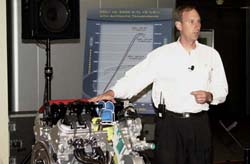 |
|
|
In front of international press at the Corvette Z06 introduction on May 1, 2000, John
Juriga, GM Powertrain Assistant Chief Engineer for Gen III Passenger Car Engines, debuted his team’s
latest and greatest, the LS6. Photo: author
Click Image For Larger View |
|
The LS6 and the LS1 use an all-aluminum cylinder case. It’s a "deep-skirted" design (block structure extends below the crankshaft centerline) with six-bolt main bearing caps (four vertical bolts and two horizontal bolts per cap) and, for minimal block distortion and maximum head gasket clamping force, head bolt threads are deep in the main bearing bulkheads. Both LS1 and LS6 blocks are semi-permanent mold castings of 319-T5 aluminum, however, the LS6 case is different from LS1 unit in the design and strength of the main bearing bulkheads.
As the pistons move up and down, they force air in and out of the spaces (or "bays") beneath them. At high rpm, this reciprocating air flow is violent and really whips up the oil. While the LS1 block has some machined openings between bays, the LS6 block, because the engine has about 500 more usable rpm, needed larger windows at the base of each cylinder to better accommodate "bay-to-bay breathing."
|
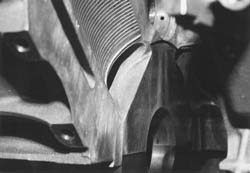 |
| |
We
got the GMPT guys to cut up a LS6 block for us. To above-left of
the #2 main bearing bulkhead, at the bottom of the cylinder bore,
you can easily see the rectangular bay-to-bay breathing window.
Photo: author
Click Image For Larger View |
Obviously, cutting windows at the bottom the cylinders reduces the strength of the block’s key structural areas, the main bearing bulkheads. With 40 more horsepower, 400-500 more rpm and even more powerful derivations of this engine soon-to-come, the block needed to be even stronger than it would be without the windows. It doesn’t take a rocket scientist to figure, in their ruthless pursuit of power, Dr. John and his engineers had to do more than simply reprogram their CNCs to cut those windows. Finite element design work along with a lot of thrashing engines to death (in a few cases, literally) on the dyno eventually resulted in the special LS6 block having both the bay-to-bay breathing windows and more overall strength than the LS1 block.
Like the LS1, LS6 blocks use centrifugally-cast, gray-iron liners which are cast into the case at the foundry. Their bore is 99 millimeters (3.8976-in.). ’97 and ’98 LS1s could not be
overbored. For 1999, liners changed such that a service overbore of .010-in. was possible and this carries over to the LS6.
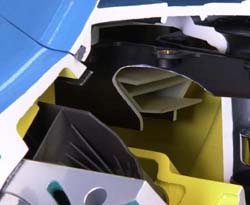 |
|
|
LS6’s
valley mounted oil separator is similar in concept to the system
used a decade before in the LT5. It uses internal baffling to force
the crankcase vapors in a circuitous flow. In the process, the oil
separates and drains back into the engine. Photo: GMPT
Communications
Click Image For Larger View |
|
The LS6 crankshaft is the same cast, nodular iron unit with rolled-fillet journals used by LS1s since 1997. Its stroke of 92 mm (3.6620-in), makes the LS6's displacement 5.665 liters or 345.69 cubic inches. Drilled main bearing journal centers reduce weight and assist in bay-to-bay breathing. For the 2001 model year (MY01), the crankshaft’s reluctor wheel which triggers the crankshaft position sensor, was redesigned to enhance sensor signal output. For MY01, all Gen IIIs use a new main bearing that has reduced diameter variation. That allowed a slight decrease in main bearing clearance which reduces the potential for bearing knocks during starts in extremely cold weather from engines having bearings on the high-side of the variation. Lastly LS6 cranks use a lightweight harmonic damper with an aluminum hub which is 2.6 pounds lighter than the LS1 damper.
The sintered, forged and
shotpeened, PF1159M steel, 6.1-inch connecting rod introduced in 1997 carries over to the LS6. Beginning in MY01, all Gen III rod cap screws are stronger through a change in manufacturing process used to heat-treat and roll the screw’s threads. This particular change came as a result of the LS1’s use in the American Speed Association
(ASA) race series during 1999.
LS6 puts out more power and runs faster so it has a brake-mean-effective-pressure
(b.m.e.p.) that peaks about 15% higher than LS1’s. Because of this, LS6 needs a more robust piston. The new piston, as well as all other Gen III and Gen II pistons, is made by
Mahle. The LS6 unit is cast of a eutectic aluminum/silicon alloy called "Mahle 142". Both M142 and the previous material, M124, also contain small amounts of copper and nickel, but M142 has slightly more of both. Mahle 142, offers increased strength and less expansion at high temperature. That offers better control of piston-to-bore clearance, both at the skirt and the ring lands. The improved dimensional stability prevents piston noise along with enhancing durability and oil control. Because the LS6 piston material has more favorable expansion characteristics, the slight barrel-shaped profile used in the machining of the piston had to be changed, too.
Camshaft
and Valve Train
|
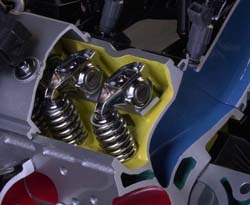 |
| |
The
only valve train item that changes from LS1 to LS6 is the valve
springs. All the other pieces carry over. Photo: GMPT Communications
Click Image For Larger View |
While the camshaft in the LS6 is more aggressive than LS1 cams, its basic construction is the same: machined from a steel billet, rifle-drilled for less mass and with a camshaft position reluctor just ahead of the rear journal.
Jim Hicks is the guy at GM Powertrain who does Gen III camshafts and the Registry learned a lot from him in three different telephone interviews. LS6 valve lift is .525-in., intake, and .525-in., exhaust, compared to .500/.500 for the MY00, Y-car, LS1 profile. Measured at .050-in. tappet lift, LS6 intake duration is 204° and exhaust is 211°. The LS1 for MY00 was 198°/208°. The LS6 lobe centers are 116° apart where as LS1 has them at 115.5°. At .050-in. tappet lift, both cams have no overlap, but at .005 lift, LS6 overlap is 45° and LS1, 49°. The overlap numbers make the new cam seem less aggressive but, that’s clearly not the case.
"Even though the LS1 looks like it has more overlap based on degrees,"
Jim Hicks commented, "the LS6 actually has more overlap based on lift area–.52 vs. .42 inch-degrees. That is why it’s better to use lift area to quantify a lot of this cam data rather than just degrees."
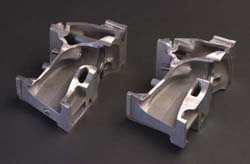 |
|
|
Looking
at these side views of the LS6 intake port (left) and the LS1 intake
port, it’s very easy to see the difference in the port floors and
the short-turn radii. Photo: GMPT Communications
Click Image For Larger View |
|
With today’s varying lobe configurations, comparing cams by the area under the profile seems like a better choice. Another issue to consider: up to now, virtually all Gen III camshaft duration data released by GM’s various communications entities has been "altered" to facilitate comparison to Gen I and Gen II Small-Block V8 profiles which, except for the LT4, used 1.5 rocker ratios. The specifications listed here are not skewed to a specific rocker ratio. Again, the duration numbers in degrees, when used for comparison purposes, can be deceiving. Lift area, in in./deg., is a more consistent method of measurement.
Why does the LS6 have more actual overlap when, measured by duration in degrees, it appears not to? The LS6 valve accelerations and open/close ramp configurations are dramatically different from those of the LS1. The accelerations are higher," Hicks continued, "especially the negative acceleration over the nose, which increased about 10%. That’s where the increased lift and duration come from. We also changed the ramps. In the ’97 model year we put constant velocity opening and closing ramps on the cam to limit valve train noise. For 2001, because (LS6) is a more aggressive application, we went back to a constant acceleration opening and closing which moves the valve faster. That gives us more lift area and allows us to run tighter lobe centers (than with constant velocity ramps having the same lift). With this profile there is a slight increase in valve train noise, but for this application, (ie: the Z06) it was deemed acceptable.
"Opening and closing ramp velocity is a kind of a compromise we’re always going back-and-forth on, depending on the application. If a cam is going into a Cadillac Escalade, for instance
(luxury SUV powered by the 6.0-liter, truck version of the Gen III), we wouldn’t have aggressive valve openings and closings. We’d skew the profile’s ramps towards lower noise. For this particular application–being a two-seat, light-weight, near racecar you can drive on the street–the right compromise was to take a small increase in valve train noise in exchange for more lift area, tighter lobe centers and the increased performance they bring.
Obviously, with more lift, duration, higher acceleration rates and more usable rpm, the LS6 needs a more aggressive valve spring. Erroneous information in Chevrolet’s ’01 Corvette Media Materials book, states the only difference between the LS6 and LS1 valves springs is tighter winding. In our interview with Jim Hicks, we learned the LS6 spring is made of different material (chrome/silicon/vanadium steel wire vs LS1’s chrome/silicon steel wire) and has a different wire shape (oval vs. round), as well as, being wound more tightly. These three features make a big difference in valve spring pressure: on the seat, 90 lbs for the LS6 vs. 76lbs for the LS1, and over the nose, 260lbs for the LS6 vs 220lbs for LS1.
The rest of the LS1 valve train, including the 1.7:1, investment cast steel, roller-fulcrum rockers carry over to the LS6. Generally, the Gen III valve train is more robust and lighter than the Gen II/I pieces. It’s geometry is better and the natural frequency of the Gen III valve train is 740 Hz where as the old Small-Blocks were in the high 600s. This is why the Gen IIIs can rev higher than production Gen Is and
IIs.
|


